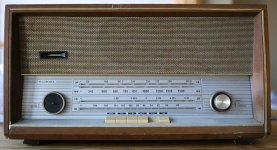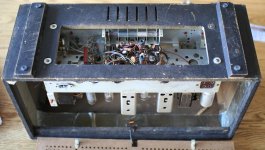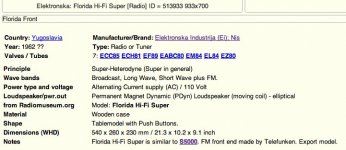Member
Joined 2009
Paid Member
Member
Joined 2009
Paid Member
It's a radio, aka wireless.
Does it work?
w
No idea, I don't fancy putting a wire into this thing until I learn a bit more about it - like is it isolated from the mains for example.
There's a phono input on the back.
It has two separate tuner dials as if there are at least 2 radio's inside, one is FM the other is AM.
It looks too darn complicated for me to fix it if it turns out not to work.
What self-restraint! I'd have plugged it in by now. I do have a couple of posts in the 'Stupid Things I've Done' thread tho'.
It'll have two separate front ends, with independent tuning. The AM sections will, in all probability, use the same tuning cap, although there may be some gangs switched in and out. The shortwave band is fairly limited, from ~5.8 to 6.2 MHz. Shortwave by definition runs ~3-30 MHz. I see there's also a PU selector, this is to allow connection of a turntable or other pickup. You can test the audio section by injecting a signal with PU selected. Shame about the missing volume knob. Be careful there, it's not impossible the protruding metal end of the pot is live.
It won't be too difficult to debug, it's tubes after all. It's a fairly recent radio since it's got FM. You'll be able to figure out a lot by looking at the tube datasheets.
w
It'll have two separate front ends, with independent tuning. The AM sections will, in all probability, use the same tuning cap, although there may be some gangs switched in and out. The shortwave band is fairly limited, from ~5.8 to 6.2 MHz. Shortwave by definition runs ~3-30 MHz. I see there's also a PU selector, this is to allow connection of a turntable or other pickup. You can test the audio section by injecting a signal with PU selected. Shame about the missing volume knob. Be careful there, it's not impossible the protruding metal end of the pot is live.
It won't be too difficult to debug, it's tubes after all. It's a fairly recent radio since it's got FM. You'll be able to figure out a lot by looking at the tube datasheets.
w
Member
Joined 2009
Paid Member
self-restraint is the other side of the coin from lazy too - I don't have a power cord for it and it's not matching any kind of modern power cord I've seen. No doubt it was designed for a two-prong power cord and I'm more accustomed to an English plug where the earth pin is a whopping hunk of copper and a fuse inside the plug. Mind you that didn't help me the last time I had an old tube radio (about 15 years ago). It was a Heathkit from some dodgy shop in Cambridge. My friend and I plugged it in as soon as we got it back to our digs, and low and behold I discovered what 240V ac actually feels like !
I challenge anyone to find a schematic for this guy - seems nobody ever heard of 'Florida' as far as I can tell.
I challenge anyone to find a schematic for this guy - seems nobody ever heard of 'Florida' as far as I can tell.
Last edited:
Hey Bigun,
Nice find! It just so happens that restoring old radio sets got me into this DIY stuff.
Just looking at it, I would say it is a European radio made for the american GI trade sometime in the mid 50's to the early 60's. There were millions of these sets built during that era with 120 V mains to be sold at military PX's.
It would be most helpful to know the specific tube compliment. On these euro-style sets there's usually a tube placement diagram on the back of the cabinet cover.
The best advice I can give you in the meantime is to follow the same common sense rules you would apply to any piece of old hi-fi equipment. You've already followed the first rule by not plugging the thing in until you know what's going on "under the hood", so to speak. You just don't know what has happened to the set before you got it. I've seen several that had all the tubes "rearranged" - guaranteed to give an interesting surprise when plugged in!
Wavebourn is quite correct about these old receivers. Even the most humble sets were quite well-engineered and usually had excellent performance.
Nice find! It just so happens that restoring old radio sets got me into this DIY stuff.
Just looking at it, I would say it is a European radio made for the american GI trade sometime in the mid 50's to the early 60's. There were millions of these sets built during that era with 120 V mains to be sold at military PX's.
It would be most helpful to know the specific tube compliment. On these euro-style sets there's usually a tube placement diagram on the back of the cabinet cover.
The best advice I can give you in the meantime is to follow the same common sense rules you would apply to any piece of old hi-fi equipment. You've already followed the first rule by not plugging the thing in until you know what's going on "under the hood", so to speak. You just don't know what has happened to the set before you got it. I've seen several that had all the tubes "rearranged" - guaranteed to give an interesting surprise when plugged in!
Wavebourn is quite correct about these old receivers. Even the most humble sets were quite well-engineered and usually had excellent performance.
Last edited:
Just looking at it, I would say it is a European radio made for the american GI trade
I came to the same conclusion. If any of the tubes are original the numbers and brands may give a clue to the radios origin. Is there any information on the back panel? Tube chart? The two prong plug receptacle isn't too uncommon and looks a lot like the one used of just about every TV set made from the late 40's through the 70's.
Member
Joined 2009
Paid Member
OK, I've worked out that it was made in Yugoslavia. It has a sticker on it from the Canadian certification people. No dates.
There's a safety interlock, a red push button held in by the back cover. There's also a notice on the back cover referencing a circuit breaker too. Seems like two good safety features.
The tube compliment is shown: ECC85, ECH81, EF89, EABC80 and an EL84.
There's also a tube EM84 strapped sideways against the front grill.
Speaker is 4Ohm.
There's a safety interlock, a red push button held in by the back cover. There's also a notice on the back cover referencing a circuit breaker too. Seems like two good safety features.
The tube compliment is shown: ECC85, ECH81, EF89, EABC80 and an EL84.
There's also a tube EM84 strapped sideways against the front grill.
Speaker is 4Ohm.
a red push button held in by the back cover.
The red push button IS the circuit breaker. The safety interlock is the two prong power recepticle which should mate with a power cord attached to the back cover. Remove the cover and there is no power inside the radio. This was standard on US made TV sets for 30+ years.
And so was removing the metal clip that held the cord to the back cover as was taping down the little red button. Taping down the red button was the reason we replaced a lot of power transformers. A gassy but still functioning horizontal sweep tube was the reason for the little red button popping out.
Member
Joined 2009
Paid Member
Davorin,
Thanks for the lead ! - I found some information from searching under Ei-Nis. Seems the factory is still in business and making tubes.
The radio I have is called the Florida Hi-Fi Super, made sometime around 1962. It's a couple of years older than I am.
If you have a schematic that would be of interest.
Thanks for the lead ! - I found some information from searching under Ei-Nis. Seems the factory is still in business and making tubes.
The radio I have is called the Florida Hi-Fi Super, made sometime around 1962. It's a couple of years older than I am.
If you have a schematic that would be of interest.
Attachments
Thanks for the lead ! - I found some information from searching under Ei-Nis. Seems the factory is still in business and making tubes.
Not according to my information (for roughly a decade now). A shame, really, considering their quality (Philips tooling and manufacturing process) compared to other tubes that are still being manufactured nowadays, but apparently there was no market for those at that time which coincides with economic sanctions imposed on Serbia in the same timeframe.
Member
Joined 2009
Paid Member
Not according to my information (for roughly a decade now). A shame, really, considering their quality (Philips tooling and manufacturing process) compared to other tubes that are still being manufactured nowadays, but apparently there was no market for those at that time which coincides with economic sanctions imposed on Serbia in the same timeframe.
Pitty - strange that their web site is still up and running, somebody must be paying for it unless all they have is somebody selling off their NOS stock ?
Who we are
Pitty - strange that their web site is still up and running, somebody must be paying for it unless all they have is somebody selling off their NOS stock ?
Who we are
Check out the "last modified" date at the bottom of the page. Their website is what prompted me to inquire some 3-4 years ago and what I wrote above was response I got from a person who lived in Nis (town in Serbia where the factory is located) and was also involved with electronics so I'm inclined to believe him. He died in 2008 so I have no way of verifying the current state of affairs but the semi-abandoned website is probably a good clue.
I wonder whether the tooling is still there or not ? If it is, it would make far more sense to restart production there than to start production in the UK (considerably lower labor cost - this is fairly labor-intensive process).
- Status
- This old topic is closed. If you want to reopen this topic, contact a moderator using the "Report Post" button.
- Home
- Amplifiers
- Tubes / Valves
- Florida ? what did I get ?


